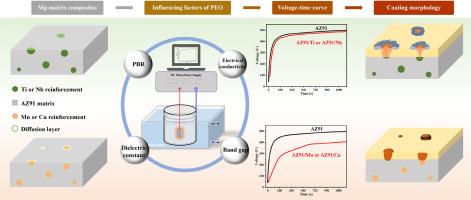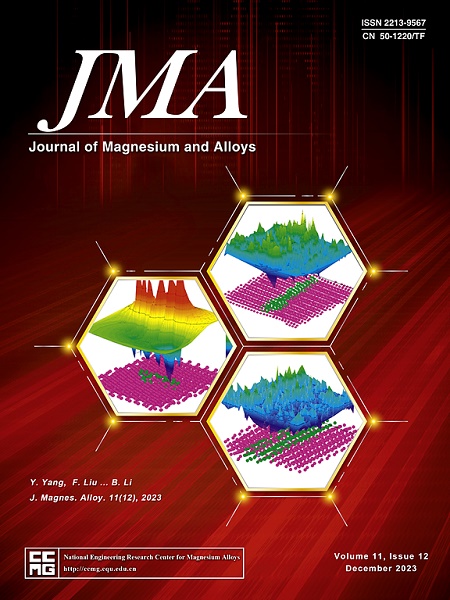Effect of different metal-reinforcement phases on PEO discharge and coating growth behavior of AZ91 Mg-matrix composites
IF 15.8
1区 材料科学
Q1 METALLURGY & METALLURGICAL ENGINEERING
引用次数: 0
Abstract
The strength and ductility of Mg alloys were improved through the introduction of metallic reinforcement phases. How the effect of different metal-reinforcement phases on the PEO discharge and coating growth behavior of Mg-matrix composites remains unclear. In this work, the influence of three metal-reinforcement phases (Nb, Mn, and Cu) on voltage evolution, coating morphology, coating phase composition, and corrosion resistance was investigated. The results indicate that Nb-reinforcement undergoes continuous spark discharges, resulting in the formation of a “volcano-like” localized morphology. In contrast, Mn and Cu-reinforcements do not directly participate in PEO discharges; instead, their oxidation products form “nodule-like” protrusions that limit the voltage rise rate. These behaviors are attributed to differences in the properties of the oxidation products of metal reinforcements and the Mg matrix, such as stability, Pilling–Bedworth ratio (PBR), band gap, dielectric constant, and conductivity. These characteristics influence the electrical structure of the PEO coating, thereby altering the PEO discharge and coating growth behavior of the composites. Finally, two models are proposed to describe the PEO discharge mechanisms in the two types of metal-reinforced AZ91-based composites.

不同金属增强相对AZ91 mg基复合材料PEO放电及涂层生长行为的影响
通过引入金属增强相,提高了镁合金的强度和塑性。不同金属增强相对镁基复合材料PEO放电和涂层生长行为的影响尚不清楚。在这项工作中,研究了三种金属增强相(Nb, Mn和Cu)对电压演变,涂层形貌,涂层相组成和耐腐蚀性的影响。结果表明,nb -强化材料在连续放电过程中形成了“火山状”局部形貌。相反,Mn和cu增强剂不直接参与PEO放电;相反,它们的氧化产物形成“结节状”突起,限制了电压的上升速率。这些行为是由于金属增强剂和Mg基体的氧化产物在稳定性、PBR、带隙、介电常数和电导率等性能上的差异造成的。这些特性影响了PEO涂层的电学结构,从而改变了复合材料的PEO放电和涂层生长行为。最后,提出了两种模型来描述两种金属增强az91基复合材料中PEO的放电机理。
本文章由计算机程序翻译,如有差异,请以英文原文为准。
求助全文
约1分钟内获得全文
求助全文
来源期刊

Journal of Magnesium and Alloys
Engineering-Mechanics of Materials
CiteScore
20.20
自引率
14.80%
发文量
52
审稿时长
59 days
期刊介绍:
The Journal of Magnesium and Alloys serves as a global platform for both theoretical and experimental studies in magnesium science and engineering. It welcomes submissions investigating various scientific and engineering factors impacting the metallurgy, processing, microstructure, properties, and applications of magnesium and alloys. The journal covers all aspects of magnesium and alloy research, including raw materials, alloy casting, extrusion and deformation, corrosion and surface treatment, joining and machining, simulation and modeling, microstructure evolution and mechanical properties, new alloy development, magnesium-based composites, bio-materials and energy materials, applications, and recycling.
 求助内容:
求助内容: 应助结果提醒方式:
应助结果提醒方式:


